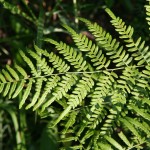Bracken Fern
Pteridium aquilinum
Dennstaedtiaceae
Description
Bracken fern is a coarse plant with slender, woody, branching, underground rhizomes that allow it to form large colonies. Its triangular, single fronds are erect-ascending and three times compound.
Like other ferns, bracken reproduces by spores produced on the back of the fronds.
Habitat
Bracken fern is found in the eastern third of Texas and the high mountains (above 7,000 feet) of Jeff Davis County. Many varieties extend across much of the United States, wherever there is adequate moisture. The plant colonies are usually found on hillsides at the edge of woodlands and thickets in partial shade.
Toxic Agent
These plants have two types of toxic agents. The first is a thiaminase, which is responsible for central nervous system disease in horses. The diet must contain 20 to 25 percent bracken fern for 3 weeks or more for horses to demonstrate clinical signs. The thiaminase is detoxified by rumen microbes, so ruminants are not affected by the plant in this way.
Bracken ferns other toxin is a norsesquiterpene lactone called ptaquiloside, and it causes disease in ruminants after several weeks or months of intake at 20 to 25 percent of the diet.
Signs of Livestock Ingestion
In horses, clinical signs of thiamine deficiency include: Anorexia; Weight loss; Incoordination; Muscle tremors.
The disease in cattle is marked by severe bone marrow suppression and bladder tumors, which result in a hemorrhagic syndrome. Clinical signs include: Hemorrhages of the mucus membranes; Weight loss; Bloody feces; Bloody urine.
Management Strategies
Bracken fern poisoning is not a big problem in Texas, as there is a limited amount of the plant and a large dose is required for poisoning.
Livestock should not be forced to consume the young plants in the spring when they are palatable. Horses with clinical signs respond to thiamine injections and removal of bracken fern from the diet. Prevention is the only treatment for ruminants.
Images
Plant Characteristics
Duration: Perennial
Stem Texture: Hairy
Growth Habit: Ferns
Leaf Shape
 : Bipinnately Compound
: Bipinnately Compound
Season: Warm
Distribution
 : 01 - Pineywoods, 02 - Gulf Prairies and Marshes, 03 - Post Oak Savannah, 04 - Blackland Prairies, 10 - Trans-Pecos
: 01 - Pineywoods, 02 - Gulf Prairies and Marshes, 03 - Post Oak Savannah, 04 - Blackland Prairies, 10 - Trans-Pecos
Distributions
Distribution refers to the ecological region in Texas that a plant has been found. You can also view a clickable map.
Book: Toxic Plants of Texas (B-6105)
Collection: Toxics
Livestock Affected: Cattle, Goats, Horses, Sheep
Livestock Signs: Abnormal Urination, Anorexia, Incoordination, Loss Of Weight, Trembling







